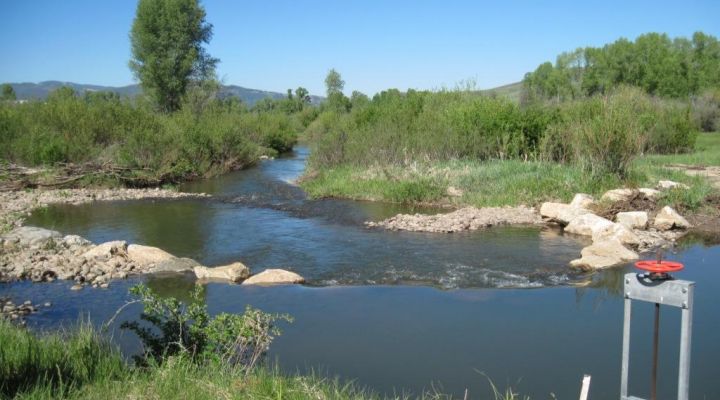Two-year effort to change system taking effect with first deals in Grand County and Aspen
Colorado water rights owners are forging a way out of the state’s ingrained “Use It Or Lose It” rule that penalizes those who divert less than their full allotment from rivers — opening a path to cut water use as shortages grip the West.
For 139 years, state enforcers have said farmers, cities and ranchers who don’t use all the water they are entitled to could have their rights curtailed. Critics have said that discourages conservation.
A first deal in the works, made possible by a 2013 law, lets a ranch owner near Granby leave water in Willow Creek, a tributary of the overtapped Colorado River, without facing penalties.
A second deal would leave more water in the Roaring Fork River, another Colorado River tributary, in Aspen.
Colorado Farm Bureau leaders said they’re watching to make sure water left in rivers by those who don’t exercise their senior rights stays available to next-in-priority irrigators.
“We’re definitely taking a wait-and-see approach,” CFB president Don Shawcroft said. “We had a certain understanding when the law was passed, but it’s certainly up to the interpretation of the court and lawyers.”
The Colorado law says not using water won’t diminish or cancel a water right if the owner is enrolled in a conservation program with local approval.
Colorado River District officials last week approved the Willow Creek deal. Water saved initially will be small, flows of a few cubic feet per second into stream channels.
But the emerging alternative to Use It Or Lose It — developed by the Colorado Water Trust — marks a milestone in modernizing the state’s first-come, first-serve system for allocating water.
“We can look at the local water rights and determine if leaving water in a particular section of a river would create environmental benefits,” said Amy Beatie, director of the trust, devoted to saving rivers.
“The benefits could be significant,” Beatie said. “On a stream, one cubic foot a second can make a big difference.”
U.S. Interior Secretary Sally Jewell in an interview last week lauded the innovation, saying arcane water rules may cause more harm than good. “They have to be dealt with,” Jewell said.
“We’re in a situation where necessity is the mother of invention. And a lot of things are getting invented by the incredible drought in California combined with the profound drought that’s been going on along the Colorado River for the last 14 years,” she said.
“You’ll see a lot more collaboration, compromising and people revisiting principles that have been in place for more than 100 years. We have got to get practical.”
In Colorado, Use It Or Lose It dates to statehood when miners competed for water needed to extract gold. Colorado leaders set up a system defining water as property where settlers who proved they’d put it to a “beneficial use” could divert it from rivers and streams.
But settlers could lose rights to water if they didn’t continue their use. Leaving water to sustain ecosystems wasn’t considered a legitimate beneficial use.
The state engineer records water use. When a farmer, rancher or city uses less than the allotted maximum over a 10-year period, state officials declare all or a part of a water right “abandoned” on a list issued every 10 years. That water no longer can be diverted and goes up for grabs to other rights holders next in priority.
Given the water pressures in the West, Louisiana-based ranch owner Witt Caruthers this year decided to try the new approach at his head-gates along Willow Creek.
“Colorado’s water system created an incentive to use our water even in times when it’s not absolutely necessary. When you’re under that pressure to use it or lose it, you’re almost forced to abuse it. That’s to the detriment of all,” Caruthers said.
He and his partners turned to the Colorado Water Trust to take advantage of the new law. Without it, he said, “You’re caught between taking what you need and taking what you are entitled to.”
When drought nearly dried up the Roaring Fork River a few years ago in Aspen, city officials began thinking about how to ensure a minimal flow by leaving water they divert from their Wheeler Ditch to irrigate parks and feed fountains.
Yet their efforts to leave water in the river led to legal challenges by competing users, who claimed the city’s senior rights must be reduced if it stops diverting its full allotment, said Phil Overeynder, utilities engineer for special projects.
“Aspen is interested in doing this. Leaving a little water in that stream is what we are trying to accomplish,” Overeynder said.
Agricultural irrigators are wary of changing Colorado water law, said John McKenzie, director of the Ditch and Reservoir Company Alliance. Yet the system causes many to flood fields with more water than they need for fear that government will list their water as abandoned, McKenzie said.
“We want to protect ditch company water rights,” he said. “But if there’s a mechanism where a ditch company that doesn’t need the water could allow it to flow down a river, and there was no ‘abandonment’ of that water, it could help a ditch company. There are costs to diverting water.”
The Denver Post
Bruce Finley
Original article
